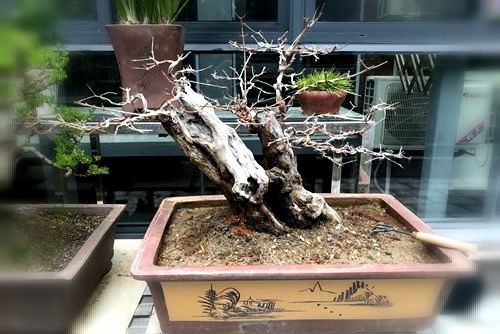Production method of cycad bonsai
The pinnate compound leaves of cycads are good materials for the art of flower arrangement. using its small plants to make bonsai has a better ornamental effect and is deeply loved by bonsai lovers. The reproduction of cycad can be divided into three methods: sowing method, tillering method and cutting dry method, but the family pot planting method is the most suitable, the method is simple and the survival rate is high. Below, Hua Cao Le shares specific practices with you for reference.
Noun analysis: when talking about plant structure, the so-called tiller bud refers not only to the tiller bud, but also to the stem of the tree that has been formed near the rhizome. In flowers, there are many species that can be propagated by tiller buds, such as chrysanthemum, but usually not called tiller buds, but called foot buds, foot buds are tiller buds, other similar. Iron trees also produce tillering buds, that is, small branches growing on the trunk, usually called sucking buds.
Production method of cycad bonsai

First, tillering time: generally choose in early May.
Second, the configuration of basin soil: the bottom of the flowerpot needs to be covered with 5 cm thick river sand, and the upper layer is about 15 cm thick. 1 big 3 river sand and 2 big 3 humus mixed soil. After laying, drench it with 3 ‰ potassium permanganate solution and cover it with plastic film. It can be put into use after 2 days.
Third, the pot method, choose to tiller in cloudy days
The main results are as follows: 1. The leaves of the tiller buds to be cut are cut off to avoid excessive transpiration after the tiller buds are cut away from the mother.
2. Remove the tillering buds from the mother with a knife or saw. The incision should be as small as possible, and the aerial roots should be retained as far as possible, but the aerial roots should be cut short if they are too long.
3. Smear the cut tiller buds with plant ash to prevent the flow of fat, and then put them in a cool and ventilated place for 5 days.
4. Soak the dry tiller buds in 3 ‰ potassium permanganate solution and bury the basal tiller buds for about 10 minutes to fully disinfect and prevent mildew. Then peel off the sandy soil and bury the tiller buds, not too deep, but the incision must be covered.
IV. Post-pot management
There is no need to water after insertion, because the soil has just been sterilized. It is necessary to build a plastic arch shed in time to prevent rain, otherwise the buds are perishable and will not produce leaves that year. After 1 month, the tiller bud will produce 1 to several rounds of neat, green new leaves, and begin to root. When the root system is more prosperous (about 3 months later), you can pour light bran cake water and fertilizer, but the frequency should not be too much. At this time, the shade canopy can be removed and let it grow naturally. Finally, a cycad bonsai was successfully made in the right place.
Time: 2019-04-24 Click:
- Prev

What should be paid attention to when watering and fertilizing boxwood bonsai?
If you want your own boxwood bonsai to grow well, watering and fertilizing is the key.
- Next

How to raise pomegranate bonsai? How to make pomegranate bonsai?
Pomegranate basin landscape dry branches, foliage, flowers and fruits, high ornamental value. Because of its strong adaptability and easy cultivation, pomegranate is often cultivated as bonsai. How to raise pomegranate bonsai? How to make pomegranate bonsai? Bonsai should be placed on the sunny balcony, the longer the sunshine, the better. If there is not enough light, the branches are easy to grow and become thinner.
Related
- Fuxing push coffee new agricultural production and marketing class: lack of small-scale processing plants
- Jujube rice field leisure farm deep ploughing Yilan for five years to create a space for organic food and play
- Nongyu Farm-A trial of organic papaya for brave women with advanced technology
- Four points for attention in the prevention and control of diseases and insect pests of edible fungi
- How to add nutrient solution to Edible Fungi
- Is there any good way to control edible fungus mites?
- Open Inoculation Technology of Edible Fungi
- Is there any clever way to use fertilizer for edible fungus in winter?
- What agents are used to kill the pathogens of edible fungi in the mushroom shed?
- Rapid drying of Edible Fungi

